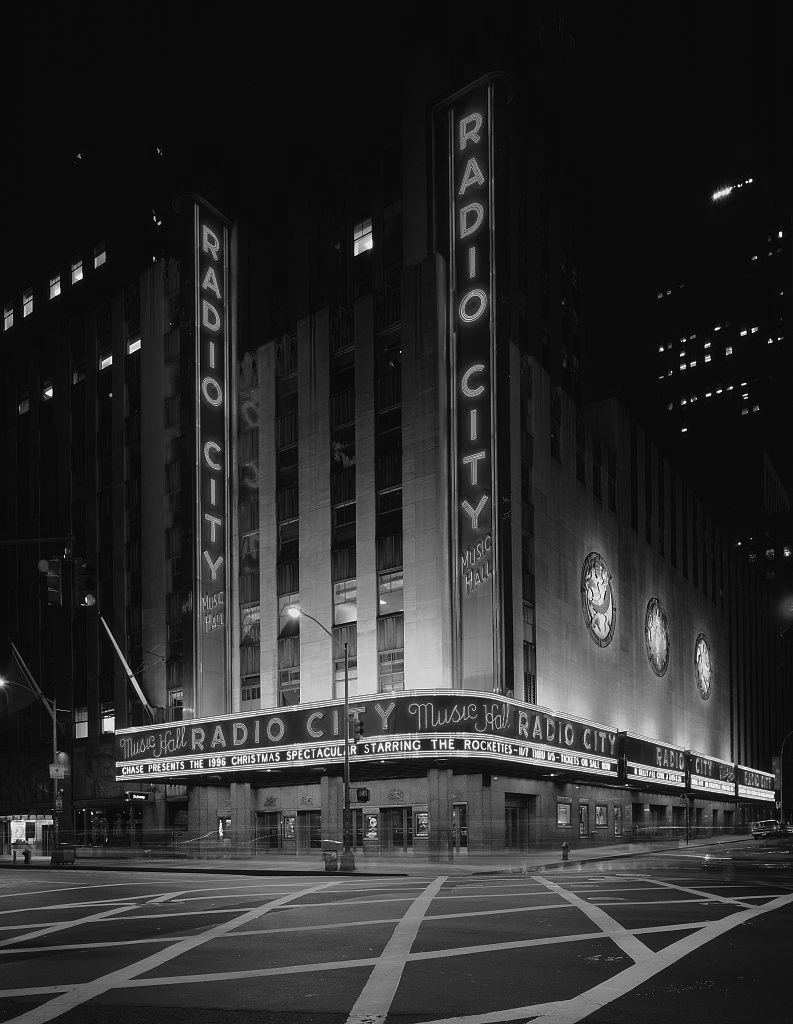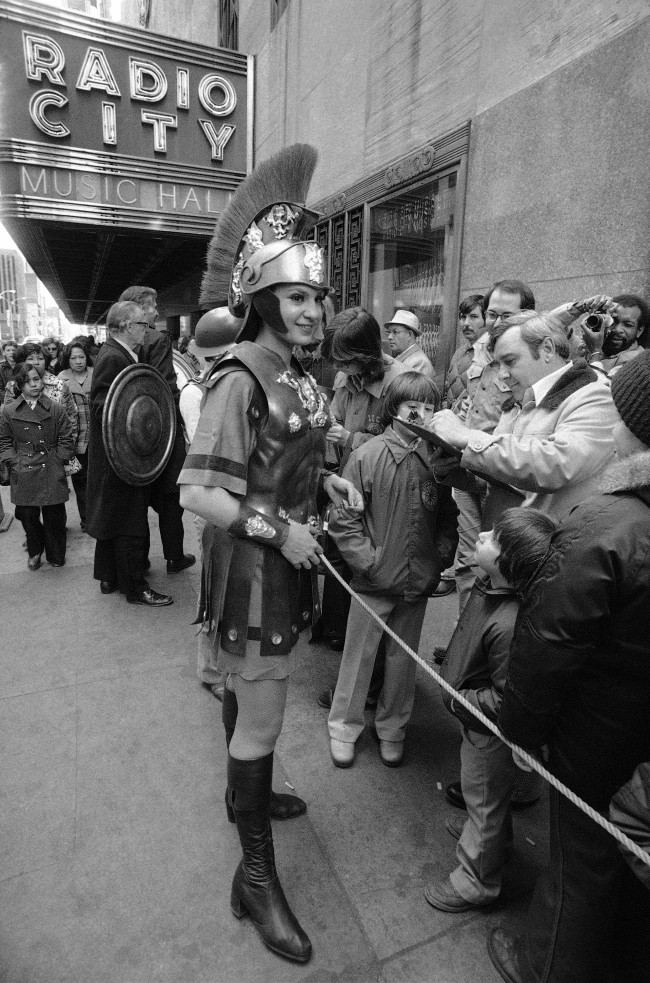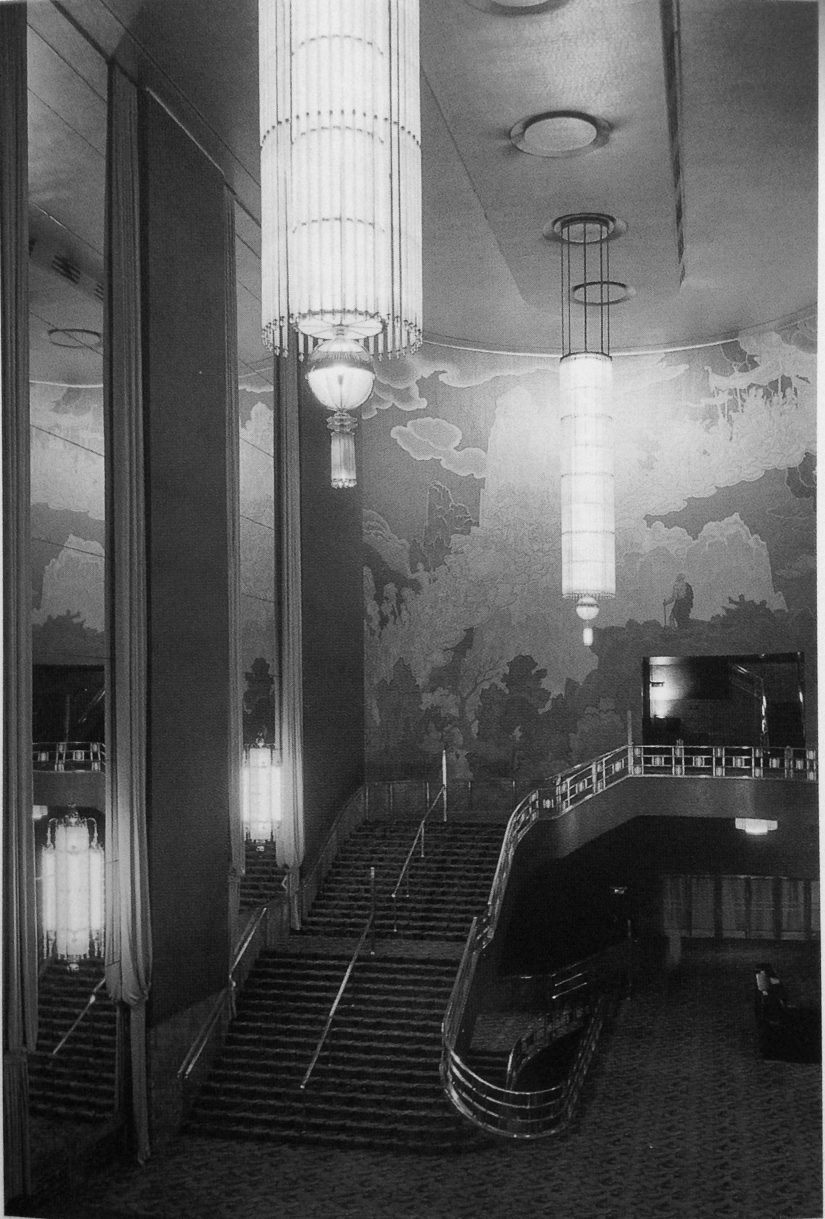
Radio City Music Hall
The threat to the nationally-significant Radio City Music Hall in the late-1970s caused New Yorkers to rally to achieve landmark designation for the Art Deco masterpiece.
Radio City Music Hall was completed in 1932 as part of the larger development of Rockefeller Center.1 It was designed by architect Edward Durell Stone and interior designer Donald Deskey in the Art Deco style, with Samuel Lionel Rothafel, or “Roxy,” a leading expert on movie palaces, as a primary advisor.2 The public areas of the music hall feature murals, sculpture, and other work by prominent artists of the time. These interiors are considered some of the most impressive in the history of modern theater design, with no equal in America in terms of scale or variety of architectural, artistic, and decorative elements. As one of the principal achievements of the Art Deco style and as one of the finest theater designs in the country, the interior of Radio City Music Hall is of unique importance to the history of American architecture.3 The Hall opened on December 27, 1932, with a lavish variety show and continued to feature films and stage productions until 1979. At this point plans were made to convert the theater into office space, but a combination of preservation and commercial interests resulted in the protection of Radio City Music Hall and in 1980, after a renovation, it reopened to the public.4
The interiors of Radio City Music Hall were designated a New York City Interior Landmark on March 28, 1978, and its exterior was designated a New York City Landmark as part of Rockefeller Center on April 23, 1985 .
1977: Plans to close Radio City Music Hall are announced
January 8, 1978: A “rescue committee” for Radio City Music Hall is formed
March 28, 1978: The interiors of Radio City Music Hall are designated a New York City Interior Landmark
1980: Radio City Music Hall reopens to the public
April 23, 1985: The exterior of Radio City Music Hall is designated a New York City Landmark as part of Rockefeller Center

By the late 1970s, because the venue was not financially successful, Radio City Music Hall came under risk of demolition. The president of Rockefeller Center at this time, Alton G. Marshall, announced that the hall would close in 1978 because of a $2.3 million deficit in 1977.5 Reportedly there were plans to transform the building into office space.
In response to this announcement, efforts were launched to protect the building. On January 8, 1978, Lieutenant Governor Mary Anne Krupsak proclaimed her commitment to preserve the building, and also announced the creation of a “rescue committee” of business, government, labor, and cultural group representatives that would join forces to save the hall.6 During a meeting of these groups, several suggestions were made to improve the profitability of the music hall and increase its chances of survival; the plan that sounded like “an immediate possibility,” according to Krusak, was to designate Radio City Music Hall as a New York City Landmark, which would offer significant tax savings.7 Among those who supported this effort were Senator Jacob J. Javits, Mayor of Economic Development Robert J. Milano, President of the New York Convention and Visitor’s Bureau Charles Gillett, Chairman of the State Economic Development Board Richard Ravitch, Chair of the New York State Council on the Arts Kitty Carlisle Hart, restaurateur Vincent Sardi, publicist and representative of the Association for a Better New York (ABANY) Howard Rubenstein, and Lewis Rudin (also of ABANY).8 Rosemary Novellino, captain of the Radio City Music Hall Ballet Company and president of The Showpeople’s Committee to Save Radio City Music Hall, motivated colleagues, friends, and media and political allies to support the cause. The Rockettes, the famous company of dancers that performs in Radio City Music Hall, also petitioned to help save the building, at one point joining schoolchildren with placards.9
However, there was some opposition to designation of Radio City Music Hall’s building and interior. The most vocal opponent was Alton Marshall, the president of Rockefeller Center at this time, who at a hearing before the New York City Landmarks Preservation Commission on March 14, 1978, stated that giving landmark status to the hall “may well be the last nail in the Music Hall’s coffin.”10 If the Hall was landmarked, Marshall said, “it will leave me no choice but to apply for a permit to demolish the structure the day after designation goes into effect, so that at the end of 305 days I will be free to act.”11 He added that landmark status would make it harder for a future owner of the hall to propose an alternative use for the building, but he also declared that if there is an “economically viable entertainment use” that can be found for the hall, Rockefeller Center will search for a different use for the building.12 Instead of landmark designation, Marshall stated he would agree in writing not to alter the interior of the hall in any way until November 1978, but attorney Whitney North Seymour, Sr. strongly advised the Commission to not accept this offer, since it would just lead to more negotiating and more threats to destroy the hall.13
Despite this opposition, on March 28, 1978, Radio City Music Hall’s interior was designated a landmark by the New York City Landmarks Preservation Commission. On March 29th of that same year, the New York City Board of Estimate cast a majority of votes, 16 of 22 votes, to uphold landmark designation for the hall’s interiors.14 However, Rockefeller Center still requested the option of applying for a demolition permit if the “rescue committee” failed to improve profitability.15 The hall closed on April 12, 1978, which led the New York State Urban Development Corporation (UDC) to take over its management for a trial period. Although Rockefeller Center predicted large deficits, the UDC managed to minimize financial losses, eventually turning a profit and returning management to Rockefeller Center.16
On February 28, 1979, Rockefeller Center announced that Radio City Music Hall would reopen, but diversify its entertainment.17 On April 19, 1979, plans were officially announced to implement a “master plan” to make the music hall a successful entertainment venue again, which included live stage performances, special shows aimed at diverse age groups, retaining the Rockettes, and occasionally showing films.18 In this plan, the first objective was to restore the hall to its former Art Deco grandeur, including new wallpaper and carpets that mimicked the originals and a new sound system.19 The hall reopened to the public in 1980.
By December 1997, another renovation was planned to further restore and modernize the venue.20 Completed in 1999, the renovation was led by architect Hugh Hardy of Hardy Holzman Pfeiffer Associates, and involved the installation of 6.5 miles of new gold, blue, and red neon for the block-long marquee of the music hall, covering the ceilings with 720,000 sheets of aluminum and gold leaf, and installing 5,901 new plush salmon-pink seats.21 In addition, the restoration team either replicated, cleaned, or repaired artwork, appointments, lighting fixtures, wall fabrics, carpets, and furniture throughout the entire building.22

- Oral Histories with Kent Barwick, R. Michael Brown, Joseph Rosenberg (2007) and Joseph Rosenberg (2010)
- New York Preservation Archive Project
- 174 East 80th Street
- New York, NY 10075
- Tel: (212) 988-8379
- Email: info@nypap.org
- Saving Radio City Music Hall: A Dancer's True Story by Rosemary Novellino-Mearns (TurningPointPress, 2015)
- Victoria Newhouse, Wallace K. Harrison, Architect (New York: Rizzoli International Publications, Inc., 1989), page 44.
- Ibid, page 47.
- New York City Landmarks Preservation Commission, Radio City Music Hall Designation Report, 28 March, 1978, page 2.
- Victoria Newhouse, Wallace K. Harrison, Architect (New York: Rizzoli International Publications, Inc., 1989) , pages 48-49.
- Lesley Oelsner, “Efforts to Save Music Hall Started,” The New York Times, 7 January 1978, page A1.
- Pranay Gupte, “Panel Suggests ‘Rescue’ Plans for Radio City,” The New York Times, 9 January 1978, page A1.
- Ibid, page A28.
- Ibid, page A28.
- Ibid, page A1.
- Robert Monroe, “Landmark Tag Called Threat to Music Hall,” Schenectady Gazette, 15 March 1978, page 27.
- Ibid, page 27.
- Ibid, page 27.
- Ibid, page 27.
- “Votes Are Pledged On Landmark Status For the Music Hall,” The New York Times, 30 March 1978, page 1.
- Pamela G. Hollie, “Center Seeks Permit to Demolish Radio City if Rescue Plans Fail,” The New York Times, 5 May 1978, page 1.
- Ada Louise Huxtable, “Architecture View: Update on The Music Hall,” The New York Times, 22 April 1979, page 33.
- Joseph P. Fried, “Radio City Hall Is To Stay Open Under New Plan: Company Set Up to Devise Changed Programming,” The New York Times, 28 February 1979, page B1.
- Richard F. Shepard, “Music Hall to Be Restored; New Show Format Set,” The New York Times, 19 April 1979, page 1.
- Ibid, page 1.
- Glenn Collins, “Radio City, With Face-Lift, Reopens,” The New York Times, 5 October 1999, page 2.
- Ibid, page 2.
- Ibid, page 2.


